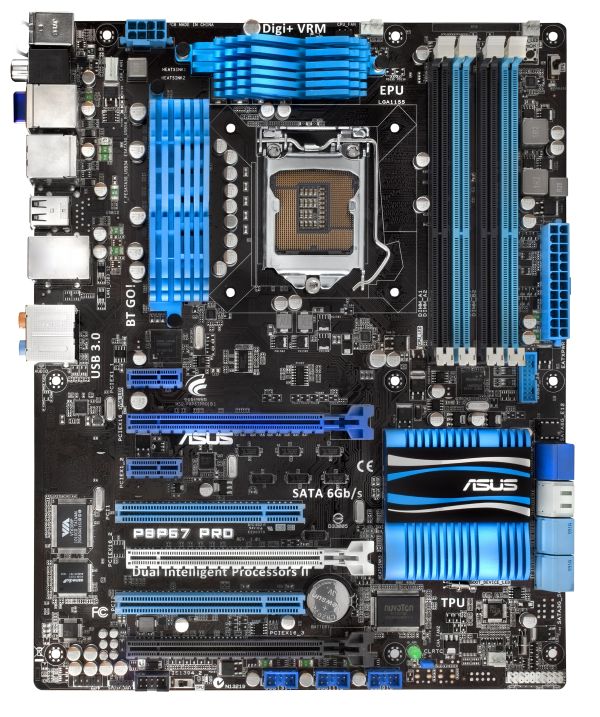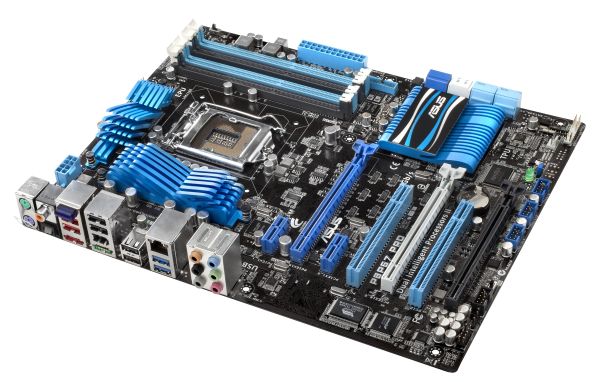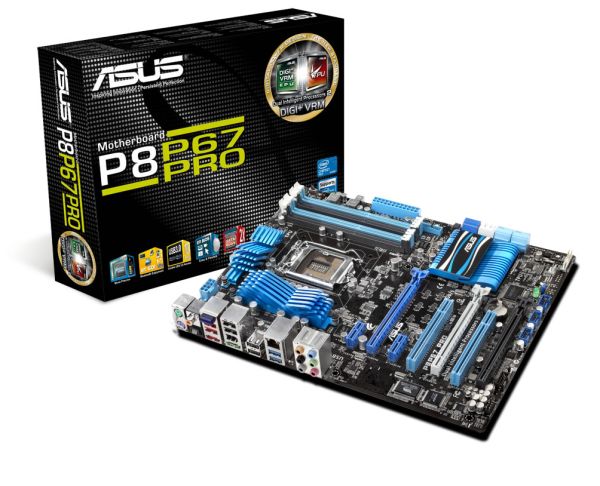The Battle of the P67 Boards - ASUS vs. Gigabyte at $190
by Ian Cutress on January 20, 2011 4:15 PM EST- Posted in
- Motherboards
- Gigabyte
- Asus
- P67
The ASUS P8P67 Pro fits near the beginning of the line-up in the ASUS launch, which in terms of ATX sized boards include the P8P67, the P8P67 Pro, the P8P67 Evo, the P8P67 Deluxe, the Sabertooth P67, the P8P67 WS SuperComputer and the top end Maximus IV Extreme. Therefore, with that in mind, we would expect to be looking at something above the base – slightly more (or better) features than the cheap boards available, enough to warrant the price difference. An overview of the P8P67 series is below:
| P8P67 Series | ||||||
| P8P67 LE | P8P67 | P8P67 PRO | P8P67 EVO | P8P67 Deluxe | ||
| Price | $140 | $160 | $190 | $210 | $235 | |
|
SATA 6 Gb/s SATA 3 Gb/s eSATA |
3 4 1 |
4 4 1 (bracket) |
4 4 2 |
4 4 2 |
4 4 2 |
|
|
CrossFireX SLI |
Yes No |
Yes No |
Yes Yes |
Yes Yes |
Yes Yes |
|
|
USB 3.0 USB 2.0 |
2 14 |
4 (2 via header) 12 |
||||
| LAN | 1 | 1 | 1 | 2 | 2 | |
| Bluetooth | No | Yes | Yes | Yes | Yes | |
Visual Inspection
ASUS have gone with the blue/white/black livery for the Pro board, with a 12+2 digital VRM design covered by slanted blue heat sinks. The socket itself is relatively clear, easily allowing large 1155/1156 CPU coolers to be fitted (remember, 1155 mounting holes are the same as 1156). The CPU fan header is located at roughly one o’clock from the socket itself, with a chassis header to the right of the DIMM slots, presumably for HDD bay type fans.
Next to this header are the EPU switch and the MemOK buttons. The EPU switch enables Energy Processing Unit, which is geared towards saving energy – this encompasses power gating certain features that are never used/used rarely, and declocking when less compute is required. The MemOK button is a physical override for overclocked memory – by holding it down until the red light comes on, at next boot, the UEFI will override the memory settings to something more suitable.
The SATA connectors come in blue (SATA 3 Gb/s), white/grey (SATA 6 Gb/s provided by the chipset) and navy blue (SATA 6 Gb/s provided by a Marvell controller). There is a USB 3.0 header also here, near the DIMM slots. These are all next to the ASUS logo and chipset cooler, which underneath have another chassis header and a green power light. This board is lacking both a debug LED and power/reset buttons on the main board, much to our disappointment.
The PCI slots are well laid out, with a PCIe 1x at the top and enough space between the first two PCIe x16 for a PCI card, meaning that at least one is available if all three PCIe x16 are occupied with dual slot cards. The black PCIe x16 slot is wired up as an x4 slot (as it shares bandwidth with the x1 slots, two USB 3.0 ports and the eSATA ports), and with a dual slot card in there, will cover most of the board USB headers.
The TPU switch is underneath the PCI slots, and performs the same function as the TurboV EVO software in the OS to optimise the system for a decent and stable overclock.
The back panel is standard, with dual PS/2 connectors, SPDIF outputs, USB 2.0 slots, USB 3.0 slots, Firewire, eSATA, audio and Ethernet. The blue module three from the left is the ASUS Bluetooth module, designed to communicate with Bluetooth devices to enhance overclocking or utilise music management. The gigabit Ethernet is handily powered by an Intel chip.














137 Comments
View All Comments
kmmatney - Monday, January 24, 2011 - link
Agreed. The last 3 motherboards I bought all came free (or close to it) in a Microcenter deal. 2 AMD system, and one Intel (socket 775). They all have decent overclocking, and have been plenty stable. Your better off spending the money you save on more RAM, or an SSD.MobiusStrip - Sunday, January 23, 2011 - link
"I'ma get that"You left out the wrong word. The "a" is the beginning of "a-gonna"; the phrase is "I'm a-gonna" do something. If you're going to remove something, it's the "a": I'm gonna get that.
softdrinkviking - Monday, January 24, 2011 - link
For all you know, "I'ma get that" could be widely used in this person's area, how would you know?Don't correct slang, it completely defeats the purpose, and it's kind of insane.
Sufo - Tuesday, January 25, 2011 - link
The "a" is the last a of gonna. The part that is omitted is the "gonn". If you're going to be such a useless pedant, at least get your facts straight.Not the best source, but http://en.wiktionary.org/wiki/Imma
"nope"
maxnix - Thursday, April 28, 2011 - link
Unfortunately for you, spell checking isn't one of them!Spazweasel - Thursday, January 20, 2011 - link
EVGA seems late to the game. They've announced their first 1155 board (130-SB-E675-KR) on their website, but has anyone actually seen it in the wild (much less reviewed)?seamusmc - Friday, January 21, 2011 - link
Spaz, (chuckle)I thought I read somewhere in their forums that EVGA's first P67 board will be available in February.
Spazweasel - Monday, January 31, 2011 - link
http://www.anandtech.com/show/4142/intel-discovers...Okay, now we know why!
It will be interesting to see if EVGA was among the first to be saying "Hey, something's not right here" and this was the reason.
DanNeely - Thursday, January 20, 2011 - link
The obvious feature gigabytes $260/320 board shas is PCIe bridge chips that allow a huge number of USB3 ports and more x16 slots, although you're only getting higher burst performance per device since they're all still sharing the same 16 lanes from the CPU.The other traditional feature is better mofsets/mofset coolers to allow higher voltages for overclocks if you have the cooling to handle the heat.
Pjmcnally - Thursday, January 20, 2011 - link
This is a great review that I was very happy to read. I picked up the ASRock board at release but I wasn’t sure I had made a good decision.I believe there is one small error in the review, the headers for both lists of board features read “ASRock P67 Extreme4” not “Asus P8P676 Pro” or “Gigabyte P67A-UD4”.